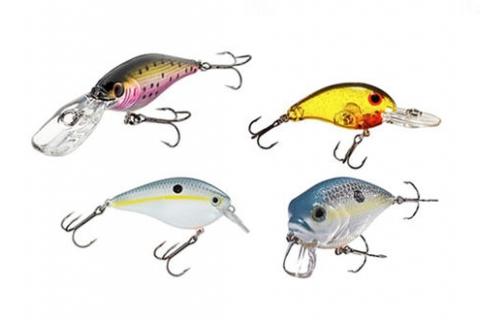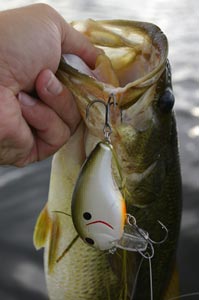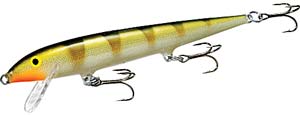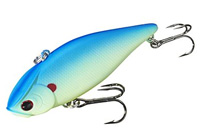
 |
| Natural Colors are useful for clear-water conditions, while bold colors such as chartreuse and firetiger excel in stained water. |
I don't know another lure with more size, shape and color variations than the crankbait. Crankbaits crowd the long walls of tackle shops everywhere, depicting shapes, sizes and hues that can cause chaos and downright confusion when you're trying to make a simple selection for the tackle box. What size do I use? How come they have different lips on them? What's with all the colors?
Yes, the questions can come fast and furious when standing there in sheer puzzlement. But it certainly doesn't have to be that way. Follow this guide on selecting the right bait for the task at hand and learn how to take the guesswork out of crankbaits.
What is a Crankbait?
A crankbait can best be described as a lure fashioned out of wood or plastic that's meant to resemble a fish (or, in some cases, a crawfish or grasshopper). It can have between one and three sets of hooks protruding from the underside of the body (normally treble hooks), and most have some sort of lip that acts as a diving device when pressure is applied. Without this lip, crankbaits would float on the surface of the water, leaving a very unappealing and out-of-reach target for most fish.
As its name suggests, crankbaits must be "cranked" or reeled through the water column to give off the desired action. It is also this cranking motion that allows them to dive to the depth that they are manufactured to go.
Many of the crankbaits currently on the market have hollow bodies or air chambers filled with small metal BBs. These BBs emit sound when the crankbait vibrates and moves through the water, which attracts fish and allows them to hone in on your bait. If the water you fish is crystal clear, or if the fish are "spooky," crankbaits without rattles are often a better bet; if the water is murky, though, tie on a rattling crank.
The Depth Factor
When dealing with crankbaits, there are three main styles of lips from which to choose.
Shallow Diver: A shallow diving crankbait possesses the smallest lip in the lineup. It will generally dive 1 to 5 feet and is primarily used for very shallow water, weed-infested water or for fish that are high in the water column.
Medium Diver: Occupying the second spot in the family of lips, the medium diver has a larger lip than shallow divers and can attain depths between 5 and 12 feet. A crankbait with this style lip can scour deeper water and enter strike zones the shallow diver cannot reach.
Deep Diver: These lures go DEEP. They possess the largest lip (some as long as two inches) and can dive down to a depth of 30 feet. This style is paramount for covering deep expanses of water, scraping the bottom in shallower spots and targeting fish that are suspended at a specific depth.
Crankbait Body Styles
Crankbaits are available in a variety of body styles, each representing a certain style of baitfish, which in turn caters to certain species of fish. The two most common styles of crankbaits you will encounter are "minnow" styles and "shad" styles.
 |
| Minnow-body cranks are long and thin, offering a wider wobble than the standard shad style. |
Minnow Body: Often refered to as "stickbaits" due to their shape, minnow-style crankbaits are tailored after the common minnow, a species found in the majority of waters throughout North America. This crankbait is long and thin in shape, offering a wider wobble than the standard shad style.
There are certain species that feed predominantly on thin minnow prey, in which case, a crankbait in this style will be your best bet to use. Walleye are at the top of the list of minnow hunters, preferring to feed on perch predominantly in the wild. If the walleye is your main quarry, stock up on minnow baits to up your odds for success.
Smallmouth bass are another species that responds well to minnow style baits. Twitching one of these cranks along a rocky shoal during early morning can lead to explosive action and excitement.
Pike and musky also prefer crankbaits in a shape that is both long and thin. (Their main prey in most waters is ciscoes, whitefish, walleye and perch.) Keep this in mind when scanning the shelves to stock your tackle box with crankbaits.
 |
| Shad baits are generally shorter than minnow baits. |
Shad Body: This style of crankbait mimics the shad. These cranks have a large, rounded head and belly tapering and thinning down to the tail section. Shad baits are generally shorter than minnow baits, and the majority of these baits have two treble hooks hanging from the belly and the tail. A tight wiggle action can be achieved when using this bait, and due to the larger body and head, they give off a greater profile when swimming through the water.
Largemouth bass are the main species targeted with shad-style crankbaits. They prefer this bigger-bodied style of crankbait to the minnow-shaped crank. Smallmouth also like a shad styles, possibly because the shape and movement looks similar to crawfish -- their favorite forage.
Flat Body Baits: This style of crank is thin and flat on both sides. The tip and tail both form a perfect point and there is no diving lip present at all. Commonly referred to as a "Rattle Trap," these cranks are meant to be reeled in fast and are classed as a "countdown bait." Countdown baits generally fall one-foot per second; count down how many feet you want your lure to be, then begin your retrieve.
 |
|
Flat-body cranks have no lip, nor do they need one since they don't float like other crankbait styles. |
Rattles are injected into the body during the molding process and create a very loud and distinct noise when pulled through the water. This acts as both a honing device and as an attractant. Most species of fish will chase down and strike this lure, including bass, pike, and musky.
Odd-Ball Bodies: The baits covered in this category are quite unique, both in their appearance and usage. A style that resembles a crawfish is dynamite for smallmouth bass; creating quite a realistic look to trick Mr. Bronzeback into thinking it's the real thing.
Other interesting body styles are what I class as "creature baits." Lumped into this category are caterpillars, grasshoppers and leech bodies. These natural looking baits seem to work well when targeting panfish or stream trout.
Crankbait Floating, Sinking, Suspending
Crankbaits usually come with a buoyancy rating on the package, clearly outlining whether they are of the Floating, Sinking or Suspending variety.
Floating: Crankbaits labeled as "Floating" will do just that -- float on the surface of the water. When the angler begins the retrieve, the crankbait will begin to dive due to the angle of the lip. If the retrieve is stopped, the crankbait will slowly begin to rise to the surface again.
Floating crankbaits are useful when fishing water that has heavy concentrations of weeds, or water that is strewn with timber or bottom clutter. When your crankbait makes contact with something — be it weeds or wood — a brief pause will allow it to float up and away from the snag.
Sinking: Sinking crankbaits will drop through the water column upon splashdown, making these lures useful for targeting suspended fish or fishing deep water. This style of bait will generally drop at a rate of a foot a second, allowing the angler to target a precise depth. (If you locate fish on your electronics at 33 feet, counting down your crankbait for 33-seconds should put you right in the strike zone.)
Suspending: Suspending baits will float on the surface, dive down on the retrieve but will "freeze" and maintain a constant depth when the reeling of the line is halted. This style of bait works wonders for finicky fish that follow, or for fish that want a bait with less action but at a constant depth. Smallmouth and walleye are prime targets for suspending baits, and this style dominates when water temperatures drop below 55 degrees.
Length The following list represents the suggested length of crankbait you should use, depending on the species you target.
| Species | Approximate Crankbait Length |
| Largemouth Bass | 2-5 inches |
| Smallmouth Bass | 2-5 inches |
| Walleye | 3-6 inches |
| Northern Pike | 4-9 inches |
| Musky | 4-12 inches |
| Crappie | 1-3 inches |
Crankbait Colors
Crankbaits come in a myriad of colors, from subtle to extreme, oftentimes attracting the angler rather than the fish! Although a variety of colors can be useful for different conditions, there are a few main ones that need to be present in everyone's tackle box.
Natural colors such as silver, baby bass, perch and walleye are useful for clear-water conditions when "matching the hatch" is vital to success. When faced with dirty conditions, a crank in chartreuse, firetiger or gold will help in adding sight and attraction to the presentation. These are the basic colors that should always be present in your box; however, with time, dozens upon dozens of colors will surely make their way home with you from the tackle store.
Shop carefully and remember this credo: clear water equals natural colors, while dirty water means flashy and over-the-top hues.
I hope that this lesson has taught you some of the finer points in selecting crankbaits. Although it can seem bewildering at first when wading through the racks, learning some of the traits and uses of crankbaits will allow you to make an informed and intelligent decision the next time you're ready to buy.
- 67063 views

